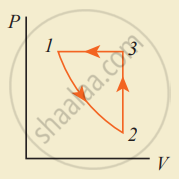Advertisements
Advertisements
Question
An ideal gas is taken through an isothermal process. If it does 2000 J of work on its environment, how much heat is added to it?
Solution
Given: W = 2000 J, isothermal process
As the gas is taken through an isothermal process, the internal energy of the gas, Δ U changes nothing and remains constant.
Therefore, the heat added to it,
Q = Δ U + W
Q = 0 + W
Q = 2000 J
APPEARS IN
RELATED QUESTIONS
Explain why The climate of a harbour town is more temperate than that of a town in a desert at the same latitude.
A thermodynamic system is taken from an original state to an intermediate state by the linear process shown in Figure

Its volume is then reduced to the original value from E to F by an isobaric process. Calculate the total work done by the gas from D to E to F
Answer in brief.
Why should a Carnot cycle have two isothermal two adiabatic processes?
For work done to be reversible, the process should be ______
Heating a gas in a constant volume container is an example of which process?
What is a thermodynamic process?
Draw a p-V diagram of the reversible process.
State the assumptions made for thermodynamic processes.
Explain the cyclic process.
Explain the thermodynamics of the isochoric process.
When a cycle tyre suddenly bursts, the air inside the tyre expands. This process is ____________.
When food is cooked in a vessel by keeping the lid closed, after some time the steam pushes the lid outward. By considering the steam as a thermodynamic system, then in the cooking process
Apply first law for an isothermal process.
Give an equation state for an isochoric process.
Draw the PV diagram for the isothermal process.
Draw the PV diagram for the adiabatic process.
What is a cyclic process?
Explain in detail an adiabatic process.
Consider the following cyclic process consist of isotherm, isochoric and isobar which is given in the figure.

Draw the same cyclic process qualitatively in the V-T diagram where T is taken along the x-direction and V is taken along the y-direction. Analyze the nature of heat exchange in each process.
An ideal gas is taken in a cyclic process as shown in the figure. Calculate
- work done by the gas
- work done on the gas
- Net work done in the process

A monoatomic gas of pressure p having volume V expands isothermally to a volume 2V and then adiabatically to a volume 16V. The final pressure of the gas is ____________.
`("ratio of specific heats" = 5/3)`
One mole of an ideal gas with `gamma` = 1.4 is adiabatically compressed so that its temperature rises from 27° C to 47° C. The change in the internal energy of the gas is (R = 8.3 J/mol.K) ____________.
Two identical samples of a gas are allowed to expand (i) isothermally (ii) adiabatically. Work done is ____________.
For an isothermal expansion of a perfect gas, the value of `(Delta "P")/"P"` is equal to ____________.
The work done on the system in changing the state of a gas adiabatically from equilibrium state A to equilibrium state B is 22.4 J. If the gas is taken from state A to B through another process in which the net heat absorbed by the system is 15.5 cal, then the net work done by the system in the latter case is ______.
( l cal = 4.2 J)
Which of the following processes is reversible?
Explain the thermodynamic process.
When an inflated ballon is suddenly burst, why is the emerging air slightly cooled?
In a cyclic process, if ΔU = internal energy, W = work done, Q = Heat supplied then ______.
